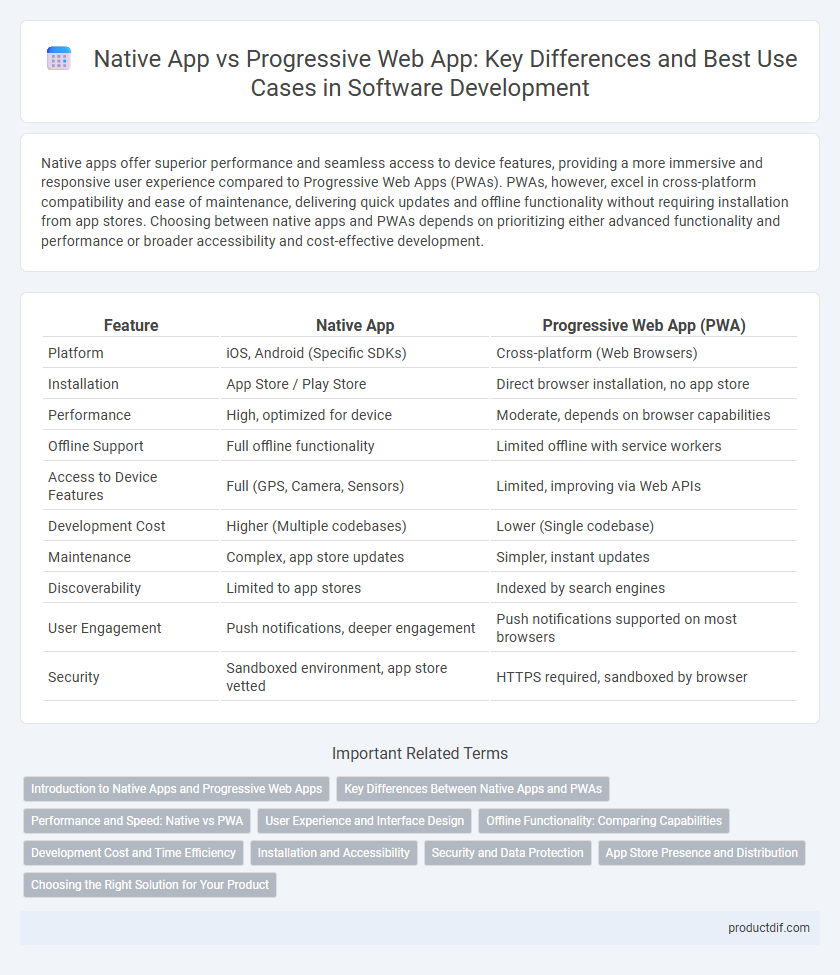Native apps offer superior performance and seamless access to device features, providing a more immersive and responsive user experience compared to Progressive Web Apps (PWAs). PWAs, however, excel in cross-platform compatibility and ease of maintenance, delivering quick updates and offline functionality without requiring installation from app stores. Choosing between native apps and PWAs depends on prioritizing either advanced functionality and performance or broader accessibility and cost-effective development.
Table of Comparison
| Feature | Native App | Progressive Web App (PWA) |
|---|---|---|
| Platform | iOS, Android (Specific SDKs) | Cross-platform (Web Browsers) |
| Installation | App Store / Play Store | Direct browser installation, no app store |
| Performance | High, optimized for device | Moderate, depends on browser capabilities |
| Offline Support | Full offline functionality | Limited offline with service workers |
| Access to Device Features | Full (GPS, Camera, Sensors) | Limited, improving via Web APIs |
| Development Cost | Higher (Multiple codebases) | Lower (Single codebase) |
| Maintenance | Complex, app store updates | Simpler, instant updates |
| Discoverability | Limited to app stores | Indexed by search engines |
| User Engagement | Push notifications, deeper engagement | Push notifications supported on most browsers |
| Security | Sandboxed environment, app store vetted | HTTPS required, sandboxed by browser |
Introduction to Native Apps and Progressive Web Apps
Native apps are software applications developed specifically for a particular operating system, such as iOS or Android, utilizing platform-specific programming languages like Swift or Kotlin to ensure optimal performance and access to device features. Progressive Web Apps (PWAs) combine the best of web and mobile apps by using modern web technologies like HTML5, CSS3, and JavaScript, offering offline access, push notifications, and fast load times without requiring installation from app stores. Both native apps and PWAs aim to enhance user experience but differ in development complexity, device integration, and distribution methods.
Key Differences Between Native Apps and PWAs
Native apps are developed specifically for a single platform using platform-specific programming languages like Swift for iOS or Kotlin for Android, enabling full access to device hardware and system features. Progressive Web Apps (PWAs) use web technologies such as HTML, CSS, and JavaScript to deliver an app-like experience through browsers, offering cross-platform compatibility with offline functionality via service workers. While native apps provide superior performance and deeper integration with device capabilities, PWAs excel in ease of deployment, automatic updates, and broader reach without requiring installation from app stores.
Performance and Speed: Native vs PWA
Native apps deliver superior performance and speed by directly accessing device hardware and OS resources, enabling faster load times and smoother animations. Progressive Web Apps (PWAs) rely on web technologies and browsers, which can introduce latency and limit hardware interaction, resulting in comparatively slower performance. However, PWAs optimize caching and resource loading techniques to minimize delays and provide near-native responsiveness in many use cases.
User Experience and Interface Design
Native apps offer superior user experience and interface design by leveraging device-specific features, smooth animations, and faster performance tailored to iOS and Android platforms. Progressive Web Apps (PWAs) provide a consistent and responsive UI across all devices through web technologies, with benefits such as offline access and instant updates, though they may lack some native hardware integration. Choosing between native apps and PWAs depends on prioritizing seamless interaction and advanced UI capabilities versus broad accessibility and ease of deployment.
Offline Functionality: Comparing Capabilities
Native apps offer superior offline functionality by fully utilizing device hardware and local storage, enabling seamless user experiences without internet access. Progressive Web Apps (PWAs) provide offline capabilities through service workers and cached resources, but their performance and feature set can be limited compared to native apps. The choice depends on the need for robust offline access and access to device-specific features.
Development Cost and Time Efficiency
Native app development often requires higher budgets and longer timelines due to platform-specific coding and testing for iOS and Android separately. Progressive Web Apps (PWAs) significantly reduce development costs and time by leveraging a single codebase that runs across multiple devices and browsers. This unified approach streamlines deployment and maintenance, making PWAs a cost-effective choice for faster market entry.
Installation and Accessibility
Native apps require installation from app stores, enabling direct access to device features like GPS and camera for enhanced performance. Progressive Web Apps (PWAs) are accessible via web browsers without installation, providing instant availability across multiple devices and platforms. PWAs offer offline capabilities through cached data, while native apps generally deliver faster load times and smoother user experiences.
Security and Data Protection
Native apps offer robust security through sandboxing, direct OS integration, and enhanced encryption protocols, reducing vulnerability to cyber threats. Progressive Web Apps (PWAs) rely on HTTPS for secure data transmission and browser-based security features but may lack deep OS-level protections compared to native apps. Both platforms must implement strong authentication, data encryption, and regular updates to mitigate risks and ensure comprehensive data protection in mobile environments.
App Store Presence and Distribution
Native apps offer prominent App Store presence, ensuring greater visibility and trust through established platforms like Apple's App Store and Google Play Store. Progressive Web Apps (PWAs) bypass traditional app stores, allowing direct distribution via web browsers, which reduces dependency on store approvals and fees. This distribution model enables instant updates but may limit discoverability compared to native app marketplaces.
Choosing the Right Solution for Your Product
Choosing between a Native App and a Progressive Web App depends on factors such as target audience, budget, and desired features. Native Apps offer superior performance and access to device-specific capabilities, making them ideal for complex, high-performance applications. Progressive Web Apps provide cross-platform compatibility, easier maintenance, and faster deployment, suitable for projects prioritizing reach and cost-efficiency without compromising user experience.
Native App vs Progressive Web App Infographic

 productdif.com
productdif.com